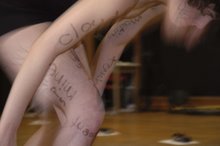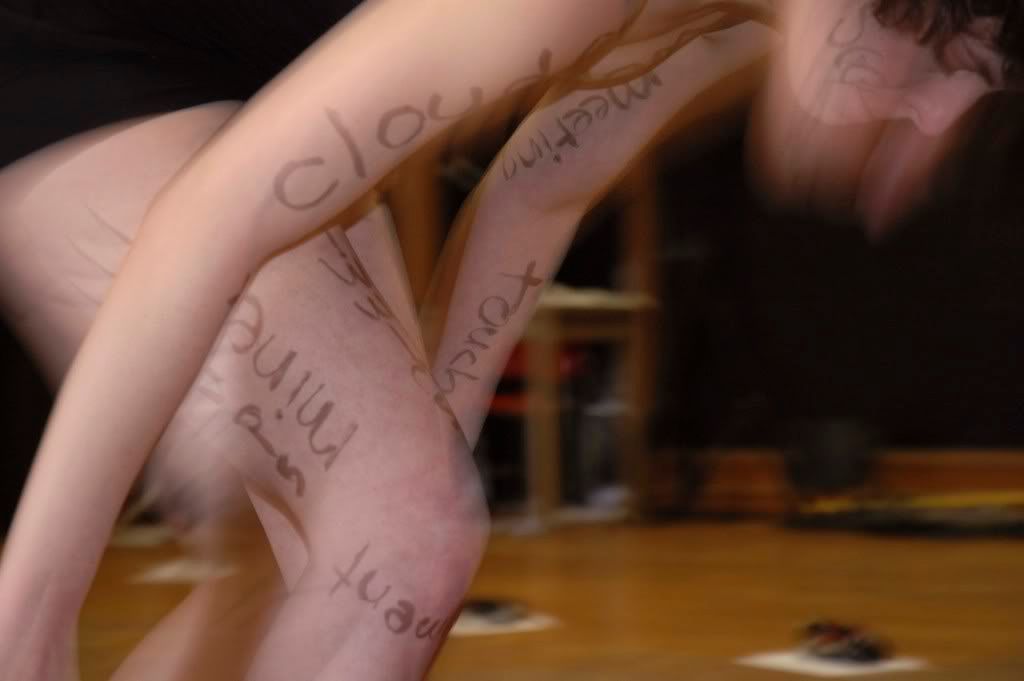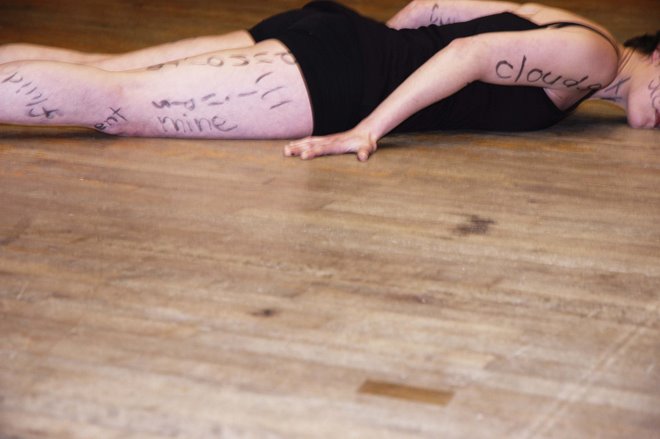The body—our bodies, other bodies, my body—is a reference book for living into the past, present, and future. It is the map of life—our lives, other lives, my life. It is both an example and a symbol of nature and nurture. It straddles the sciences. It negotiates space and time. It communicates and interprets. It is historically accurate. It is an essay on cultural ethics, gender politics, ecology, family, architecture, gerontology, comparative religion, education, sexual revolution, work ethics, and class. It is mystical and explainable. It is form and content. It is predictable and irregular. It is layered. It is taken for granted. It is worshipped and adored. It presents us to the world. I have a mild obsession with the human body.
My parents put me in dance class when I was three. I recall that early experience as: step, touch, step, touch, clap, clap, stomp. Whether or not those memories evolved from the experience, photographs, or my later work as a teacher of movement, it set me on a kinesthetic path.
My child and adult life is recorded in terms of the body. My work has been physical, in that it has been “of the body”: professional dancer, choreographer, dance teacher, waitress, bartender, cleaning woman, hoagie maker, etc. For me, writing is a channeling of experience via the body, and this could be taken to mean body experience or experience as understood by the body or experience channeled from mind through the body to the page, and all would be correct and some would probably be unaccounted for.
While living in Berlin in 1997, I had the clear realization that my life experiences, both good and bad, were stored in my body. The signal: injury. The response: ten sessions of Rolfing. The result: still injured, but I began my secondary inquiry into the body’s mind and the structural integration of bones, ligaments, fascia, memory, and experience.
On February 8, 2007, I defined what I knew about the external world. Stripped to its essence, this piece of writing pointed to how I processed that world via the body:
I know about bones and muscles, connective tissue and fascia. How the body knows more than the mind. It processes relationships better than people ever can.
I know how to dance and how to dance and not think about dancing or death or hate or the dirt under the refrigerator. I also know how to dance and think about alignment and technique and height and weight and lightness and creasing into another body and supporting.
I know the floor is support. I have practiced falling inside and outside on Marley and pavement.
So, in creating this investigative project, it seemed clear that my obsession with the body, my constant return to the internal world of connective tissue and fascia and its external world of gesture and feeling, was saying, continue moving, continue writing, continue seeing and watching, continue thinking and sleeping, continue touching and feeling, but continue in a new way.
I could read as much fact, fiction, or sci-fi that I could or will find about the human body, and I have and will read as much as I have or will have time for or mental ability to process. But in order to understand it, I need to send that information, whatever information my mind retains either voluntarily or involuntarily, into the body itself. And I need to push my ways of processing before and after that channeling.
So, with no ability to draw or understanding of drawing techniques, I began to sketch my body experiences, understandings, readings, research, and responses. And then I began recording myself responding to those sketches. And then I went into the dance studio and wrote those words onto my body, and I recorded myself responding to those body poems. So the result, I hope, is a body poem of a body poem of a body poem of a body poem. In other words, a layering of honest and impulsive (i.e., improvisational) responses of my perception of the body, which is layered and complex like our minds and our lives and our mind-realms and the realms of the worlds we live and take part in.
Immodestly, I hope to eventually discover a new body language. At this moment, this language represents only my experiences. As this project grows, I plan to include other bodies and other realms of experiencing through the body than my own frame of reference carries.
The body, as a map, provides direction, and at the same time its complexity and multi-dimensionality distorts and distracts. I am prone to distraction, and the physical and mental tangents of the body variously pull me out of line and center me. I read Claudia Rankine’s book, Don’t Let Me Be Lonely, at the perfect time. Her non-linear poetic essay demonstrated a cohesive arc of reference and experience that I needed to be reminded of, that I needed to practice in my own editing of the improvisational exercises that make up this project. (An important point: this project is a process not a project. I need to rename it, Bodiverse Process not Bodiverse Project.)
On March 10, 2007, Kristin Prevallet wrote to me, “You have laid out a multi-year project that started long before this class began and will continue long after. In it are the seeds of your own vitality.” This, followed by reading Anne Waldman’s Iovis II, where, documented in a letter from K to Anne on page 36, she writes, “But anyway, it’s this whole idea about an epic that I am finding fascinating, that is, about how one goes about bringing one’s BEING into the poem…” is when I realized this body poem process is my epic project.
In response to the last citation, I wrote: “The Body is one’s BEING. The Body is the poem. The Body is the epic of life, and if I can actually transform the poem into Body and the Body into poem, I will have found my 'something that’s big enough to fit it all in.'”
Any outside eye is helpful. Even if we disagree with it, it frames our work differently. I am particularly grateful to Christina Lundberg’s and Melissa Kozakiewicz’s close reading of my initial writings on this process. Christina asked me, “What is this project fascinated with?” And I believe that disembodied question is so important to the content of the work, because, 1) I haven’t been able to pinpoint that and 2) it is a disembodied question, which is the opposite of the embodiment of the mind/body relationship, but the same in that the concept must at some point be disembodied to write about it in an essay-like manner, rather than intuit it in a physical, improvisational one. Melissa wrote to me, “Dealing with your body problems is more interesting than dealing with someone elses. I encourage you to say the things that may be painful or gross if you have any of those things in your world.” I took this motivation with me into my improvisations, and returned to it, when I felt I was avoiding my own honesty.
The body poems posted on this blog are examples of process and product, improvisation and choreography. Each piece resulted from various genres of improvisation. The video editing was both improvisational and choreographic. How can something be improvisationally composed? I have been choreographing dances for stages, site-specific spaces, and the public realm for more than ten years. In the beginning, my choreographic structuring was conceived. I had to work hard. Today, there are many instances when it feels like muscle memory. I have no video editing experience, yet these little pieces seemed to come together as instinctually as a dance. So, to me, even the pieces that do not include a physical body in motion are dances of language, language in the sense of modes of communication. They are body poems-improvised visual choreographies of, for, and with the body.


